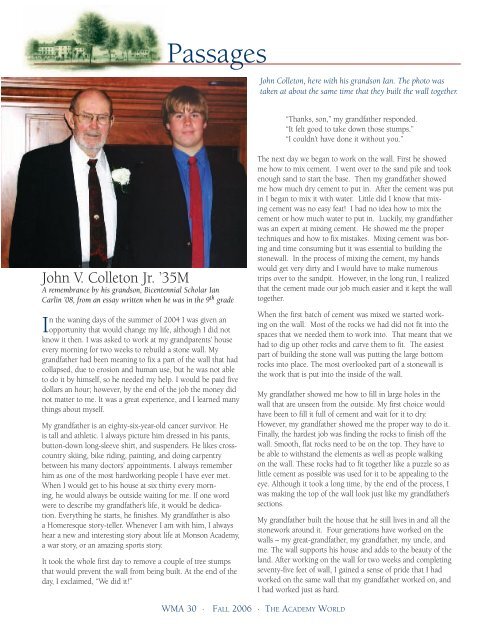THE GLOBAL CITIZEN - Wilbraham & Monson Academy
THE GLOBAL CITIZEN - Wilbraham & Monson Academy
THE GLOBAL CITIZEN - Wilbraham & Monson Academy
You also want an ePaper? Increase the reach of your titles
YUMPU automatically turns print PDFs into web optimized ePapers that Google loves.
John V. Colleton Jr. ’35M<br />
A remembrance by his grandson, Bicentennial Scholar Ian<br />
Carlin ’08, from an essay written when he was in the 9th grade<br />
In the waning days of the summer of 2004 I was given an<br />
opportunity that would change my life, although I did not<br />
know it then. I was asked to work at my grandparents’ house<br />
every morning for two weeks to rebuild a stone wall. My<br />
grandfather had been meaning to fix a part of the wall that had<br />
collapsed, due to erosion and human use, but he was not able<br />
to do it by himself, so he needed my help. I would be paid five<br />
dollars an hour; however, by the end of the job the money did<br />
not matter to me. It was a great experience, and I learned many<br />
things about myself.<br />
My grandfather is an eighty-six-year-old cancer survivor. He<br />
is tall and athletic. I always picture him dressed in his pants,<br />
button-down long-sleeve shirt, and suspenders. He likes crosscountry<br />
skiing, bike riding, painting, and doing carpentry<br />
between his many doctors’ appointments. I always remember<br />
him as one of the most hardworking people I have ever met.<br />
When I would get to his house at six thirty every morning,<br />
he would always be outside waiting for me. If one word<br />
were to describe my grandfather’s life, it would be dedication.<br />
Everything he starts, he finishes. My grandfather is also<br />
a Homeresque story-teller. Whenever I am with him, I always<br />
hear a new and interesting story about life at <strong>Monson</strong> <strong>Academy</strong>,<br />
a war story, or an amazing sports story.<br />
It took the whole first day to remove a couple of tree stumps<br />
that would prevent the wall from being built. At the end of the<br />
day, I exclaimed, “We did it!”<br />
Passages John Colleton, here with his grandson Ian. The photo was<br />
taken at about the same time that they built the wall together.<br />
WMA 30 · FALL 2006 · <strong>THE</strong> ACADEMY WORLD<br />
“Thanks, son,” my grandfather responded.<br />
“It felt good to take down those stumps.”<br />
“I couldn’t have done it without you.”<br />
The next day we began to work on the wall. First he showed<br />
me how to mix cement. I went over to the sand pile and took<br />
enough sand to start the base. Then my grandfather showed<br />
me how much dry cement to put in. After the cement was put<br />
in I began to mix it with water. Little did I know that mixing<br />
cement was no easy feat! I had no idea how to mix the<br />
cement or how much water to put in. Luckily, my grandfather<br />
was an expert at mixing cement. He showed me the proper<br />
techniques and how to fix mistakes. Mixing cement was boring<br />
and time consuming but it was essential to building the<br />
stonewall. In the process of mixing the cement, my hands<br />
would get very dirty and I would have to make numerous<br />
trips over to the sandpit. However, in the long run, I realized<br />
that the cement made our job much easier and it kept the wall<br />
together.<br />
When the first batch of cement was mixed we started working<br />
on the wall. Most of the rocks we had did not fit into the<br />
spaces that we needed them to work into. That meant that we<br />
had to dig up other rocks and carve them to fit. The easiest<br />
part of building the stone wall was putting the large bottom<br />
rocks into place. The most overlooked part of a stonewall is<br />
the work that is put into the inside of the wall.<br />
My grandfather showed me how to fill in large holes in the<br />
wall that are unseen from the outside. My first choice would<br />
have been to fill it full of cement and wait for it to dry.<br />
However, my grandfather showed me the proper way to do it.<br />
Finally, the hardest job was finding the rocks to finish off the<br />
wall. Smooth, flat rocks need to be on the top. They have to<br />
be able to withstand the elements as well as people walking<br />
on the wall. These rocks had to fit together like a puzzle so as<br />
little cement as possible was used for it to be appealing to the<br />
eye. Although it took a long time, by the end of the process, I<br />
was making the top of the wall look just like my grandfather’s<br />
sections.<br />
My grandfather built the house that he still lives in and all the<br />
stonework around it. Four generations have worked on the<br />
walls – my great-grandfather, my grandfather, my uncle, and<br />
me. The wall supports his house and adds to the beauty of the<br />
land. After working on the wall for two weeks and completing<br />
seventy-five feet of wall, I gained a sense of pride that I had<br />
worked on the same wall that my grandfather worked on, and<br />
I had worked just as hard.


